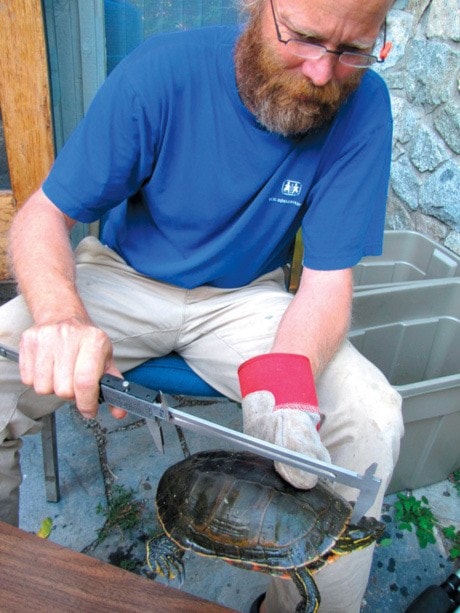A grandmother of a turtle tottered her way across Oldfield Road, narrowly escaping an encounter with a mini van. An alert neighbour spotted the endangered turtle May 31 and helped her cross safely to her nest on a nearby grassy slope.
She’s a well-known old lady on Oldfield near Nicholas Road. Habitat Acquisition Trust is conducting a scientific road threat assessment for western painted turtles in order to help stabilize this rare and declining population. They expect the elderly resident has faced near misses with vehicle traffic since she hatched from an egg in 1971.
“We suspect road mortality is a huge threat for the populations around here,” said Todd Carnahan, land care co-ordinator for HAT. “We haven’t really focused a lot of attention up there because there are so many other hot spots. [But] if there’s one, there’s lots more.”
Painted turtles are known to live near Elk and Beaver lakes, Langford Lake and Great Central Lake near Port Alberni. While the species lives in many other places, their presence is often unknown. Work in 2009 to restore Adam Kerr Park brought turtles back to the surface of that ecosystem.
“Peninsula Streams, one of our partner groups, did a bit of hydrology work to create a wetland … [and] a turtle showed up and used it,” he said. “We discovered the workers next door had found at least two turtles … We are gradually restoring links to habitats.”
Vancouver Island’s only native freshwater turtle is vulnerable around pets and vehicles when laying eggs on land. Racoons, otters and pets are known to eat the the eggs and baby turtles. HAT is looking for solutions to these threats and citizen scientists can play an important role in our research.
“Thanks to landowners that have helped us find turtles, we are gaining a better understanding of their distribution and preferred habitats. We need to learn more about their movements on land during the summer nesting season,” said Christian Engelstoft, a HAT herpetologist participating in the study.
If you see a turtle in Central Saanich feel free to snap a photo, but please don’t take it home.
“Please don’t touch the turtles unless they’re in mortal danger,” Carnahan said. “Everybody’s got a story about a turtle that’s lost, but it’s not lost unless you pick it up and abduct it.”
Turtles dig nests up to 300 metres from their aquatic habitats.
“The most information we get is from citizen scientists. Whether it’s on water or a road, dead or alive, we want to hear about it because that’s critical research,” Carnahan said.
Citizen scientists can send turtle photos and report sightings to todd@hat.bc.ca or call 250-995-2428.
Did you know?
Painted turtles have a low and smooth upper shell. While the turtle’s upper shell is dark green, the underside features striking orange to red patterns that give them the name painted turtle. Hatchlings are no larger than a loonie, while adults can reach 25 centimetres in length and can grow to the ripe old age of 50.
